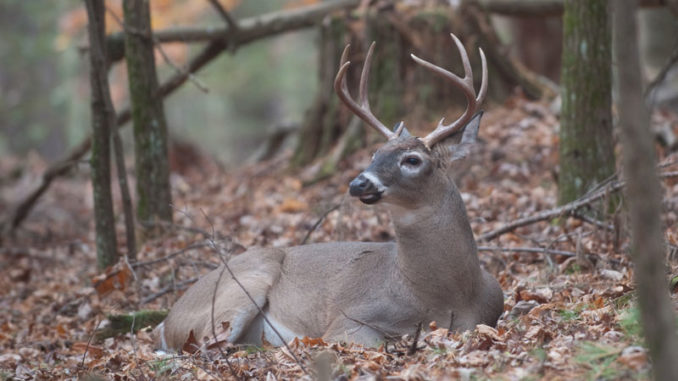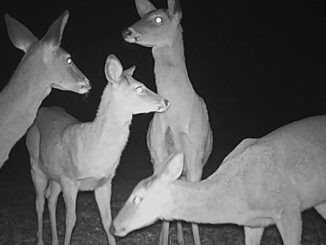
Chronic Wasting Disease (CWD) is here to stay for now, and it is up to hunters to try to keep it contained.
Unfortunately, Louisiana Animal Disease Diagnostic Laboratory (LADDL) detected its first CWD case in Tensas Parish last year.
According to Johnathan Bordelon, Louisiana Department Wildlife and Fisheries (LDWF) deer program manager, officials have caught the disease in its early stages in Louisiana.
“Obviously, early in the disease when there are very few positives in the landscape there is not very much environmental contamination happening, so at that point for another deer to become positive, it would have to come in contact with another positive animal,” he said.
But, with each CWD-infected deer, the environment is potentially contaminated more.
“With each additional positive, there are that many more positive animals walking around,” Bordelon said. “The environment contamination grows with the increased number of positive animals and eventually reaches a point where there could be so much environmental contamination that the environment itself could become almost a likely source to infect a deer.”
To try to keep infected-deer numbers low, LDWF established a control area in Tensas and Madison parishes and 10 miles of Franklin Parish.
In the control area, supplemented feeding is prohibited along with carcass transportation.
The export of any carcass or part of a carcass originating within a control area is prohibited, except for: meat that is cut and wrapped; meat that has been boned out; quarters or other portions of meat with no part of the spinal column or head attached, antlers, clean skull plates with antlers, cleaned skulls without tissue attached, capes, tanned hides, finished taxidermy mounts and cleaned teeth.
“It could certainly buy us some time and keep us from moving the disease unintentionally into new areas,” Bordelon said.
Proper disposal
Additionally, Bordelon recommends those hunting in the control area take extra precautions with the harvested deer.
“Good practice in the field is not to move or dispose of carcasses in areas outside of where you hunt,” he said. “This is just a good rule of thumb regardless of the disease in this case, but it is just more important simply because of the ability of this disease to persist in that carcass.”
When the carcass eventually breaks down and decomposes, it has the potential to be infected or contaminated by CWD if left and not properly disposed. With that, simply cleaning and skinning and field dressing the deer in close proximity to where that deer is taken is a good practice.
“In the event that the deer would be positive to CWD, you at least haven’t redistributed the disease to a new area,” Bordelon said.
Scavengers could also play a part in spreading CWD. If a scavenger, like a bear, ingests an infected deer, it could contaminate its tissue. Those prions would be in that animal, but according to current information, CWD only affects deer. Although bears could spread CWD through their scat.
When taking a deer for processing, Bordelon recommends labeling the harvested deer with a unique identifier.
“Hunters could have harvested three or four deer that year but maybe only one is positive,” he said. “Being able to discern which deer is which, they could retain the venison of the deer the disease is not detected in and probably dispose of the venison in the positive animal.”
“That will keep the disease from spreading into new areas,” Bordelon said. “That should be the focus.”
Proper carcass disposal
The carcass of an infected deer can expose other deer to the disease, directly or indirectly. Long after an infected carcass decomposes, the soil will remain infectious for years, possibly exposing other deer to the prions that cause CWD.
To avoid this exposure risk, the following disposal methods are recommended:
- Burial on site: Whenever possible, deer carcasses should be buried on the property where the animal was harvested. Burial should be deep enough to prevent scavengers from removing and displacing the remains.
- Approved, lined landfills: Infectious prions are highly unlikely to migrate out of an approved sanitary landfill and infect other deer. Carcasses and parts can be disposed of in household garbage that is hauled to a landfill via regular trash collection.
- Leave in place: If burial is not possible where the deer was harvested, the carcass may be left on-site. While this will not prevent scavengers from scattering potentially infectious parts, those parts will remain on the landscape where the deer was taken. If CWD is already present on that property, it will likely remain there and not be moved to another property where the disease does not occur.
Improper carcass disposal
- Disposal in water: Do not dispose of carcasses in ponds, lakes or waterways. This has the potential to spread infectious prions to areas previously uninfected.
- Burning: Only commercial incinerators are capable of generating enough heat for a long enough duration to destroy the prions.
- Transport to another property: Remains of harvested deer which are transported to a different property for processing should not be dumped on the landscape where it could infect the environment.
According to Bordelon, LDWF and others are performing more CWD research with the goal of obtaining more helpful information.
“With so many states having positive deer, there is much more research going on than 20 years ago,” he said. “Some of the things that are difficult now to answer, we may have a clearer answer to in the future. Some of what we are talking about now may change. What we know about the disease is terrible. It is 100% fatal; it’s transmissible. It can be persistent in the environment for decades.”

